An Overview of Le Corbusier: His Impact and Influence on Architecture
VerifiedAdded on 2023/06/10
|7
|2290
|137
Essay
AI Summary
This essay delves into the life and career of Le Corbusier, a highly influential architect and urban planner known for his significant contributions to modern architecture. It examines his early influences, including his education in enameling and engraving, his travels, and his exposure to various architectural styles. The essay highlights his purist manifesto, his innovative city planning projects, and his designs for both individual houses and large-scale housing complexes. It also addresses the controversies he faced, such as the League of Nations competition scandal, and his later works, including religious buildings and the city planning of Chandigarh, India. The essay concludes by reflecting on Le Corbusier's legacy as a mistreated genius and a solitary architect, ultimately recognized for his marvelous architectural gifts to the world.
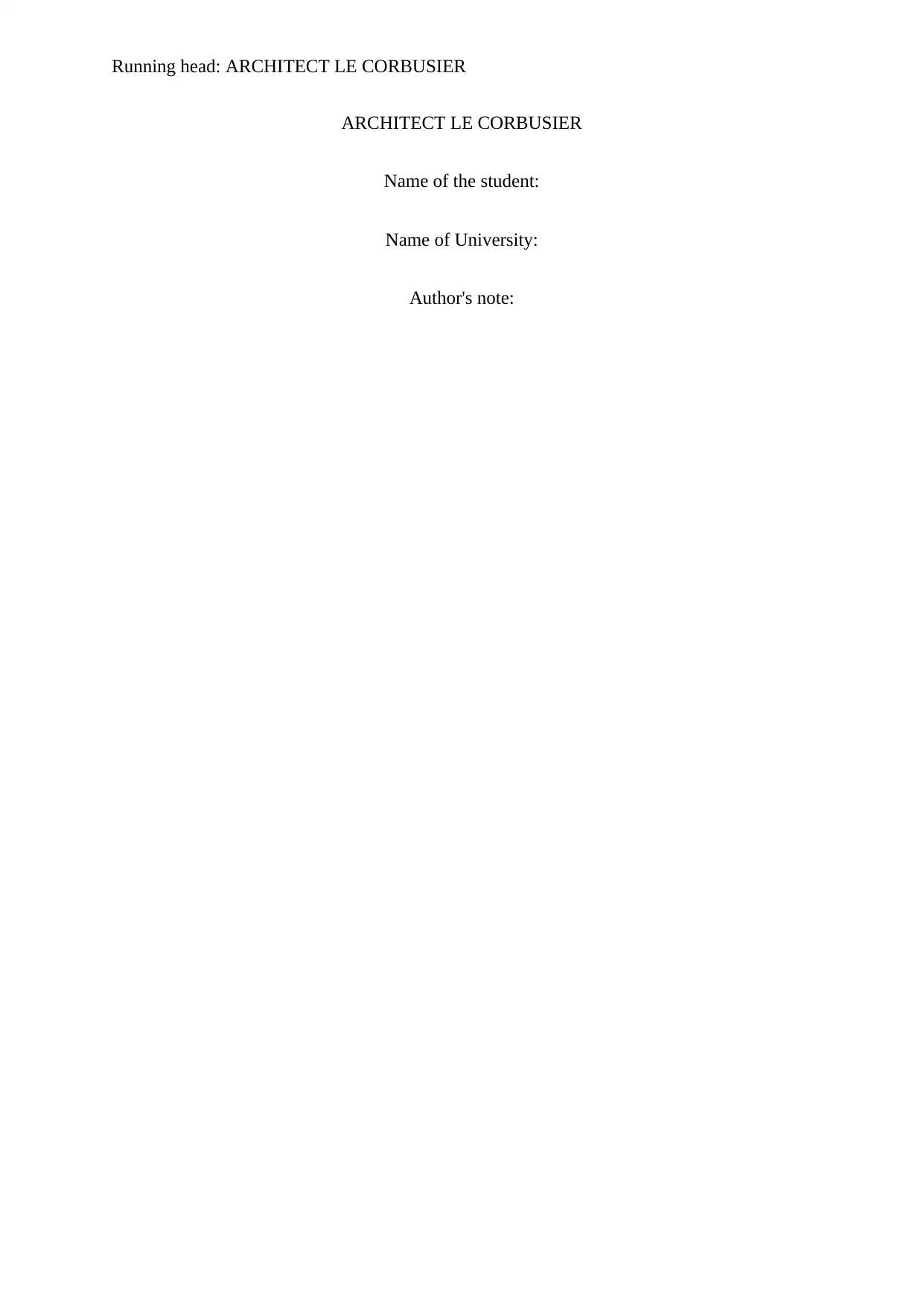
Running head: ARCHITECT LE CORBUSIER
ARCHITECT LE CORBUSIER
Name of the student:
Name of University:
Author's note:
ARCHITECT LE CORBUSIER
Name of the student:
Name of University:
Author's note:
Paraphrase This Document
Need a fresh take? Get an instant paraphrase of this document with our AI Paraphraser
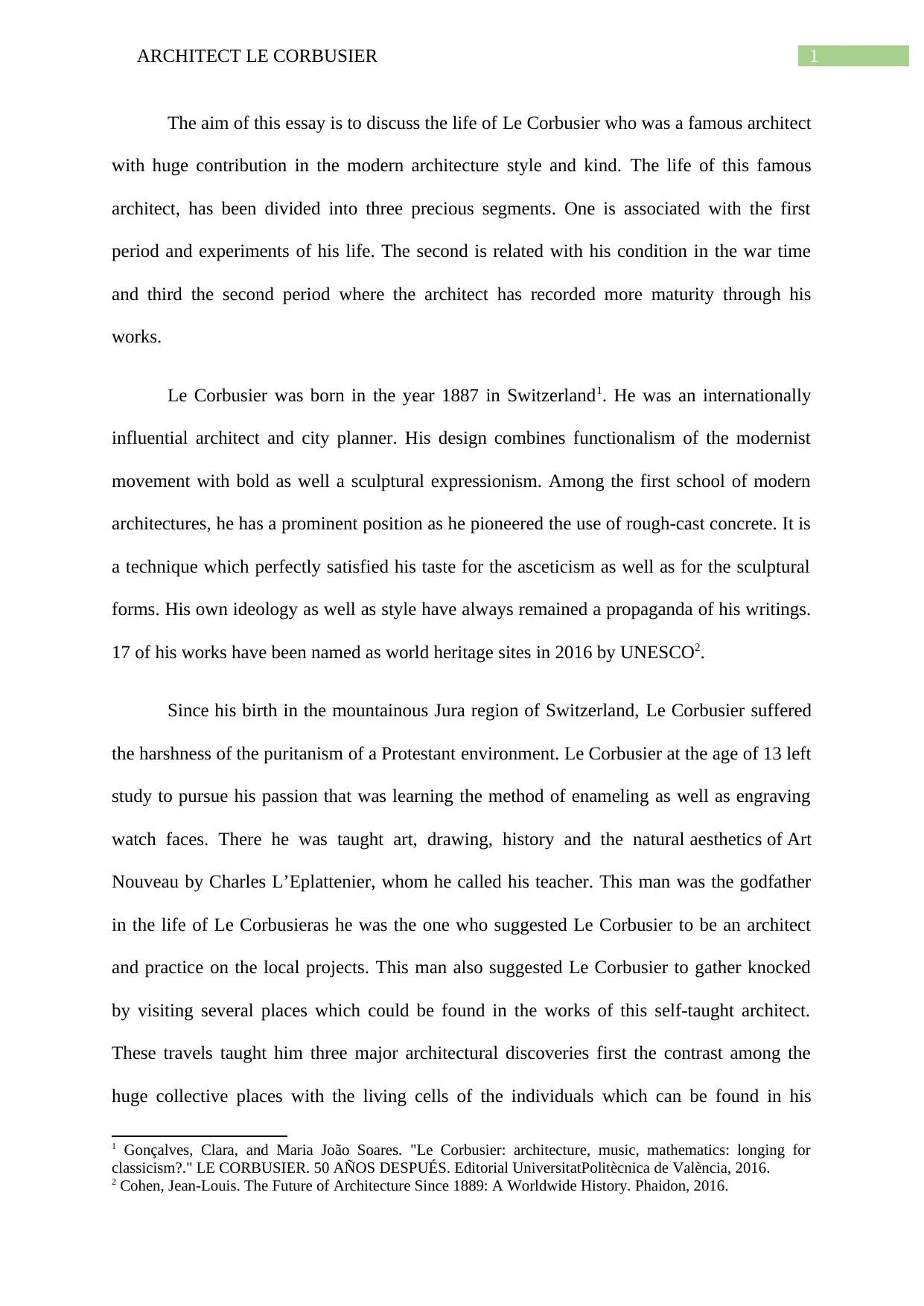
1ARCHITECT LE CORBUSIER
The aim of this essay is to discuss the life of Le Corbusier who was a famous architect
with huge contribution in the modern architecture style and kind. The life of this famous
architect, has been divided into three precious segments. One is associated with the first
period and experiments of his life. The second is related with his condition in the war time
and third the second period where the architect has recorded more maturity through his
works.
Le Corbusier was born in the year 1887 in Switzerland1. He was an internationally
influential architect and city planner. His design combines functionalism of the modernist
movement with bold as well a sculptural expressionism. Among the first school of modern
architectures, he has a prominent position as he pioneered the use of rough-cast concrete. It is
a technique which perfectly satisfied his taste for the asceticism as well as for the sculptural
forms. His own ideology as well as style have always remained a propaganda of his writings.
17 of his works have been named as world heritage sites in 2016 by UNESCO2.
Since his birth in the mountainous Jura region of Switzerland, Le Corbusier suffered
the harshness of the puritanism of a Protestant environment. Le Corbusier at the age of 13 left
study to pursue his passion that was learning the method of enameling as well as engraving
watch faces. There he was taught art, drawing, history and the natural aesthetics of Art
Nouveau by Charles L’Eplattenier, whom he called his teacher. This man was the godfather
in the life of Le Corbusieras he was the one who suggested Le Corbusier to be an architect
and practice on the local projects. This man also suggested Le Corbusier to gather knocked
by visiting several places which could be found in the works of this self-taught architect.
These travels taught him three major architectural discoveries first the contrast among the
huge collective places with the living cells of the individuals which can be found in his
1 Gonçalves, Clara, and Maria João Soares. "Le Corbusier: architecture, music, mathematics: longing for
classicism?." LE CORBUSIER. 50 AÑOS DESPUÉS. Editorial UniversitatPolitècnica de València, 2016.
2 Cohen, Jean-Louis. The Future of Architecture Since 1889: A Worldwide History. Phaidon, 2016.
The aim of this essay is to discuss the life of Le Corbusier who was a famous architect
with huge contribution in the modern architecture style and kind. The life of this famous
architect, has been divided into three precious segments. One is associated with the first
period and experiments of his life. The second is related with his condition in the war time
and third the second period where the architect has recorded more maturity through his
works.
Le Corbusier was born in the year 1887 in Switzerland1. He was an internationally
influential architect and city planner. His design combines functionalism of the modernist
movement with bold as well a sculptural expressionism. Among the first school of modern
architectures, he has a prominent position as he pioneered the use of rough-cast concrete. It is
a technique which perfectly satisfied his taste for the asceticism as well as for the sculptural
forms. His own ideology as well as style have always remained a propaganda of his writings.
17 of his works have been named as world heritage sites in 2016 by UNESCO2.
Since his birth in the mountainous Jura region of Switzerland, Le Corbusier suffered
the harshness of the puritanism of a Protestant environment. Le Corbusier at the age of 13 left
study to pursue his passion that was learning the method of enameling as well as engraving
watch faces. There he was taught art, drawing, history and the natural aesthetics of Art
Nouveau by Charles L’Eplattenier, whom he called his teacher. This man was the godfather
in the life of Le Corbusieras he was the one who suggested Le Corbusier to be an architect
and practice on the local projects. This man also suggested Le Corbusier to gather knocked
by visiting several places which could be found in the works of this self-taught architect.
These travels taught him three major architectural discoveries first the contrast among the
huge collective places with the living cells of the individuals which can be found in his
1 Gonçalves, Clara, and Maria João Soares. "Le Corbusier: architecture, music, mathematics: longing for
classicism?." LE CORBUSIER. 50 AÑOS DESPUÉS. Editorial UniversitatPolitècnica de València, 2016.
2 Cohen, Jean-Louis. The Future of Architecture Since 1889: A Worldwide History. Phaidon, 2016.
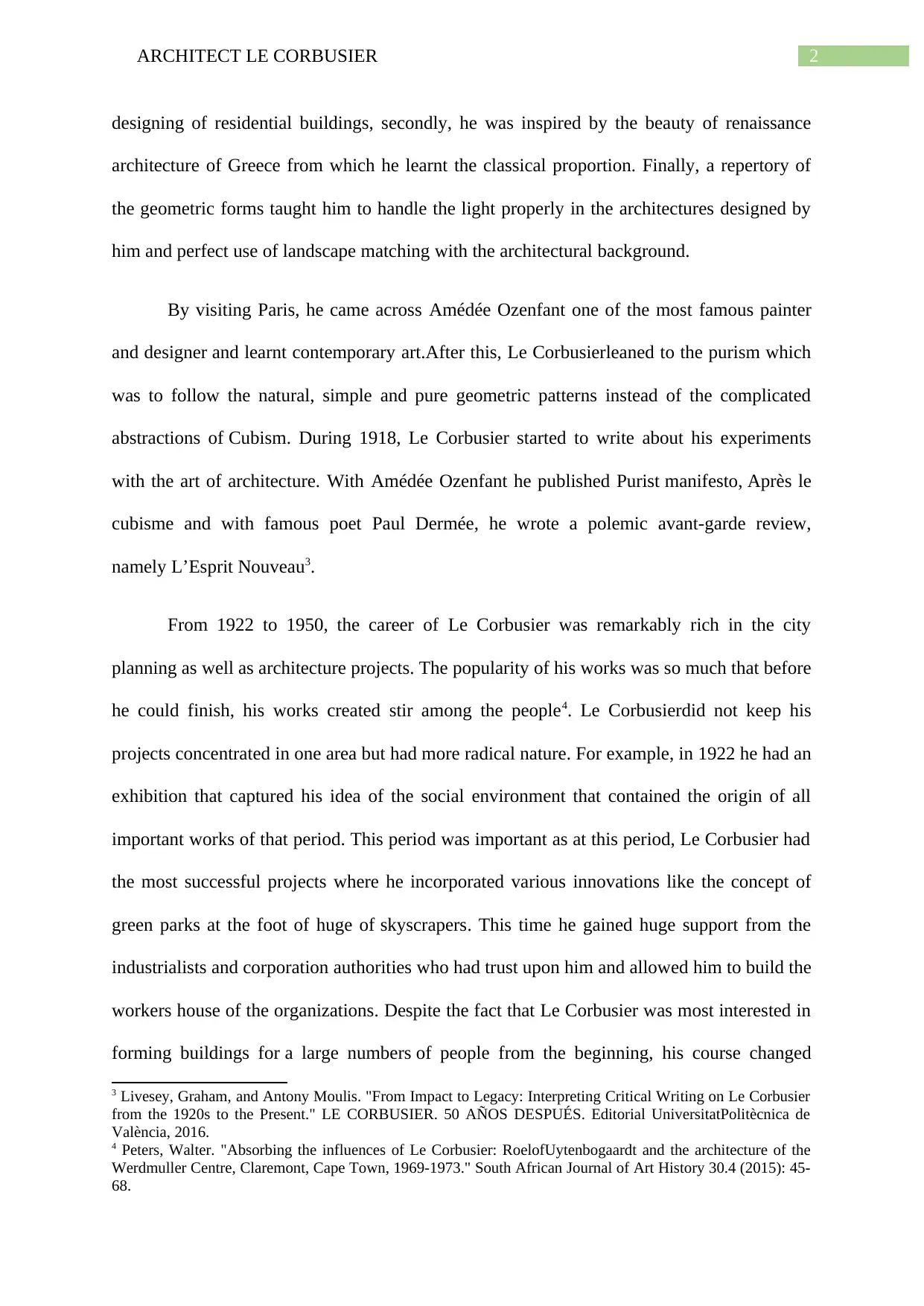
2ARCHITECT LE CORBUSIER
designing of residential buildings, secondly, he was inspired by the beauty of renaissance
architecture of Greece from which he learnt the classical proportion. Finally, a repertory of
the geometric forms taught him to handle the light properly in the architectures designed by
him and perfect use of landscape matching with the architectural background.
By visiting Paris, he came across Amédée Ozenfant one of the most famous painter
and designer and learnt contemporary art.After this, Le Corbusierleaned to the purism which
was to follow the natural, simple and pure geometric patterns instead of the complicated
abstractions of Cubism. During 1918, Le Corbusier started to write about his experiments
with the art of architecture. With Amédée Ozenfant he published Purist manifesto, Après le
cubisme and with famous poet Paul Dermée, he wrote a polemic avant-garde review,
namely L’Esprit Nouveau3.
From 1922 to 1950, the career of Le Corbusier was remarkably rich in the city
planning as well as architecture projects. The popularity of his works was so much that before
he could finish, his works created stir among the people4. Le Corbusierdid not keep his
projects concentrated in one area but had more radical nature. For example, in 1922 he had an
exhibition that captured his idea of the social environment that contained the origin of all
important works of that period. This period was important as at this period, Le Corbusier had
the most successful projects where he incorporated various innovations like the concept of
green parks at the foot of huge of skyscrapers. This time he gained huge support from the
industrialists and corporation authorities who had trust upon him and allowed him to build the
workers house of the organizations. Despite the fact that Le Corbusier was most interested in
forming buildings for a large numbers of people from the beginning, his course changed
3 Livesey, Graham, and Antony Moulis. "From Impact to Legacy: Interpreting Critical Writing on Le Corbusier
from the 1920s to the Present." LE CORBUSIER. 50 AÑOS DESPUÉS. Editorial UniversitatPolitècnica de
València, 2016.
4 Peters, Walter. "Absorbing the influences of Le Corbusier: RoelofUytenbogaardt and the architecture of the
Werdmuller Centre, Claremont, Cape Town, 1969-1973." South African Journal of Art History 30.4 (2015): 45-
68.
designing of residential buildings, secondly, he was inspired by the beauty of renaissance
architecture of Greece from which he learnt the classical proportion. Finally, a repertory of
the geometric forms taught him to handle the light properly in the architectures designed by
him and perfect use of landscape matching with the architectural background.
By visiting Paris, he came across Amédée Ozenfant one of the most famous painter
and designer and learnt contemporary art.After this, Le Corbusierleaned to the purism which
was to follow the natural, simple and pure geometric patterns instead of the complicated
abstractions of Cubism. During 1918, Le Corbusier started to write about his experiments
with the art of architecture. With Amédée Ozenfant he published Purist manifesto, Après le
cubisme and with famous poet Paul Dermée, he wrote a polemic avant-garde review,
namely L’Esprit Nouveau3.
From 1922 to 1950, the career of Le Corbusier was remarkably rich in the city
planning as well as architecture projects. The popularity of his works was so much that before
he could finish, his works created stir among the people4. Le Corbusierdid not keep his
projects concentrated in one area but had more radical nature. For example, in 1922 he had an
exhibition that captured his idea of the social environment that contained the origin of all
important works of that period. This period was important as at this period, Le Corbusier had
the most successful projects where he incorporated various innovations like the concept of
green parks at the foot of huge of skyscrapers. This time he gained huge support from the
industrialists and corporation authorities who had trust upon him and allowed him to build the
workers house of the organizations. Despite the fact that Le Corbusier was most interested in
forming buildings for a large numbers of people from the beginning, his course changed
3 Livesey, Graham, and Antony Moulis. "From Impact to Legacy: Interpreting Critical Writing on Le Corbusier
from the 1920s to the Present." LE CORBUSIER. 50 AÑOS DESPUÉS. Editorial UniversitatPolitècnica de
València, 2016.
4 Peters, Walter. "Absorbing the influences of Le Corbusier: RoelofUytenbogaardt and the architecture of the
Werdmuller Centre, Claremont, Cape Town, 1969-1973." South African Journal of Art History 30.4 (2015): 45-
68.
⊘ This is a preview!⊘
Do you want full access?
Subscribe today to unlock all pages.

Trusted by 1+ million students worldwide
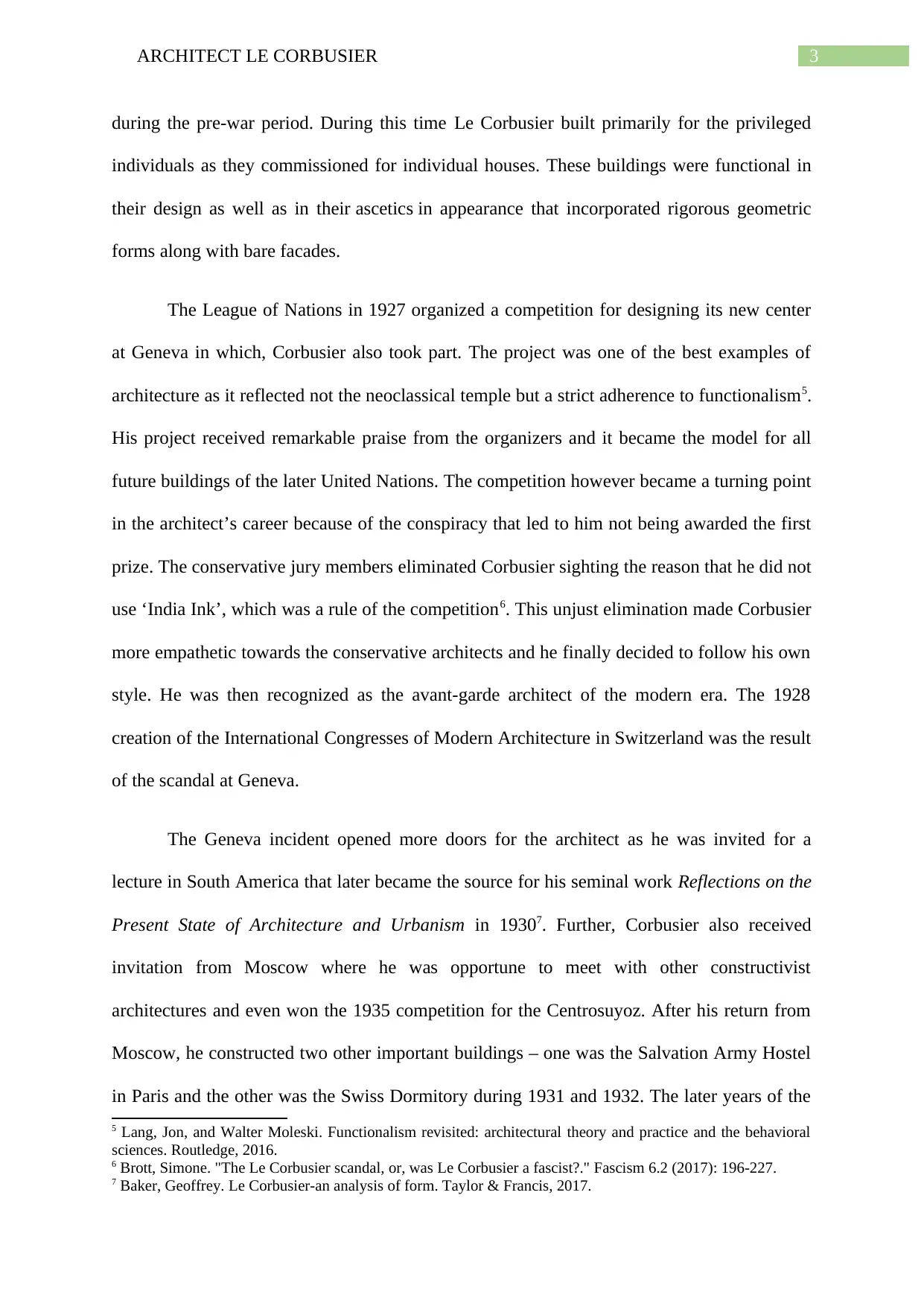
3ARCHITECT LE CORBUSIER
during the pre-war period. During this time Le Corbusier built primarily for the privileged
individuals as they commissioned for individual houses. These buildings were functional in
their design as well as in their ascetics in appearance that incorporated rigorous geometric
forms along with bare facades.
The League of Nations in 1927 organized a competition for designing its new center
at Geneva in which, Corbusier also took part. The project was one of the best examples of
architecture as it reflected not the neoclassical temple but a strict adherence to functionalism5.
His project received remarkable praise from the organizers and it became the model for all
future buildings of the later United Nations. The competition however became a turning point
in the architect’s career because of the conspiracy that led to him not being awarded the first
prize. The conservative jury members eliminated Corbusier sighting the reason that he did not
use ‘India Ink’, which was a rule of the competition6. This unjust elimination made Corbusier
more empathetic towards the conservative architects and he finally decided to follow his own
style. He was then recognized as the avant-garde architect of the modern era. The 1928
creation of the International Congresses of Modern Architecture in Switzerland was the result
of the scandal at Geneva.
The Geneva incident opened more doors for the architect as he was invited for a
lecture in South America that later became the source for his seminal work Reflections on the
Present State of Architecture and Urbanism in 19307. Further, Corbusier also received
invitation from Moscow where he was opportune to meet with other constructivist
architectures and even won the 1935 competition for the Centrosuyoz. After his return from
Moscow, he constructed two other important buildings – one was the Salvation Army Hostel
in Paris and the other was the Swiss Dormitory during 1931 and 1932. The later years of the
5 Lang, Jon, and Walter Moleski. Functionalism revisited: architectural theory and practice and the behavioral
sciences. Routledge, 2016.
6 Brott, Simone. "The Le Corbusier scandal, or, was Le Corbusier a fascist?." Fascism 6.2 (2017): 196-227.
7 Baker, Geoffrey. Le Corbusier-an analysis of form. Taylor & Francis, 2017.
during the pre-war period. During this time Le Corbusier built primarily for the privileged
individuals as they commissioned for individual houses. These buildings were functional in
their design as well as in their ascetics in appearance that incorporated rigorous geometric
forms along with bare facades.
The League of Nations in 1927 organized a competition for designing its new center
at Geneva in which, Corbusier also took part. The project was one of the best examples of
architecture as it reflected not the neoclassical temple but a strict adherence to functionalism5.
His project received remarkable praise from the organizers and it became the model for all
future buildings of the later United Nations. The competition however became a turning point
in the architect’s career because of the conspiracy that led to him not being awarded the first
prize. The conservative jury members eliminated Corbusier sighting the reason that he did not
use ‘India Ink’, which was a rule of the competition6. This unjust elimination made Corbusier
more empathetic towards the conservative architects and he finally decided to follow his own
style. He was then recognized as the avant-garde architect of the modern era. The 1928
creation of the International Congresses of Modern Architecture in Switzerland was the result
of the scandal at Geneva.
The Geneva incident opened more doors for the architect as he was invited for a
lecture in South America that later became the source for his seminal work Reflections on the
Present State of Architecture and Urbanism in 19307. Further, Corbusier also received
invitation from Moscow where he was opportune to meet with other constructivist
architectures and even won the 1935 competition for the Centrosuyoz. After his return from
Moscow, he constructed two other important buildings – one was the Salvation Army Hostel
in Paris and the other was the Swiss Dormitory during 1931 and 1932. The later years of the
5 Lang, Jon, and Walter Moleski. Functionalism revisited: architectural theory and practice and the behavioral
sciences. Routledge, 2016.
6 Brott, Simone. "The Le Corbusier scandal, or, was Le Corbusier a fascist?." Fascism 6.2 (2017): 196-227.
7 Baker, Geoffrey. Le Corbusier-an analysis of form. Taylor & Francis, 2017.
Paraphrase This Document
Need a fresh take? Get an instant paraphrase of this document with our AI Paraphraser
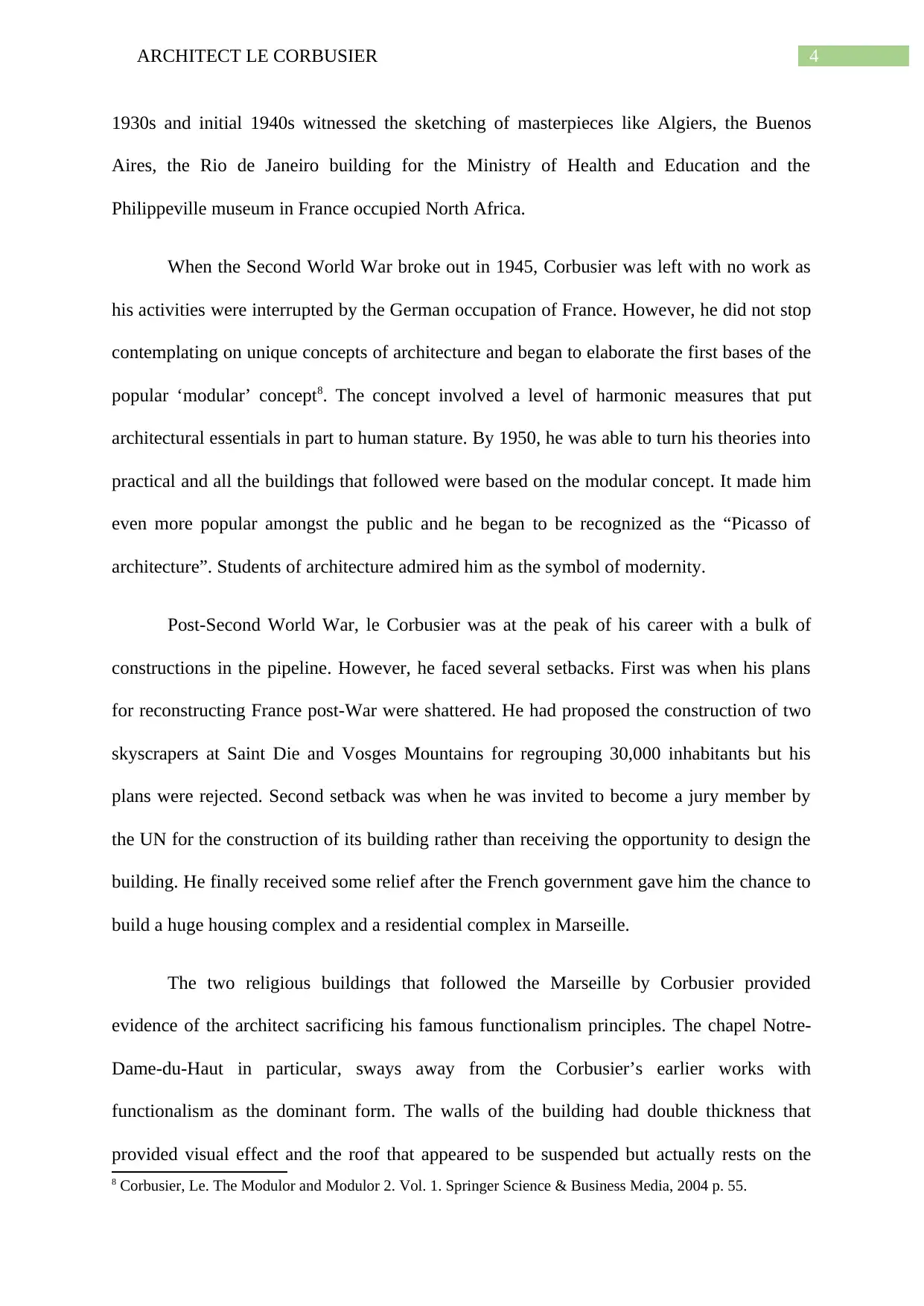
4ARCHITECT LE CORBUSIER
1930s and initial 1940s witnessed the sketching of masterpieces like Algiers, the Buenos
Aires, the Rio de Janeiro building for the Ministry of Health and Education and the
Philippeville museum in France occupied North Africa.
When the Second World War broke out in 1945, Corbusier was left with no work as
his activities were interrupted by the German occupation of France. However, he did not stop
contemplating on unique concepts of architecture and began to elaborate the first bases of the
popular ‘modular’ concept8. The concept involved a level of harmonic measures that put
architectural essentials in part to human stature. By 1950, he was able to turn his theories into
practical and all the buildings that followed were based on the modular concept. It made him
even more popular amongst the public and he began to be recognized as the “Picasso of
architecture”. Students of architecture admired him as the symbol of modernity.
Post-Second World War, le Corbusier was at the peak of his career with a bulk of
constructions in the pipeline. However, he faced several setbacks. First was when his plans
for reconstructing France post-War were shattered. He had proposed the construction of two
skyscrapers at Saint Die and Vosges Mountains for regrouping 30,000 inhabitants but his
plans were rejected. Second setback was when he was invited to become a jury member by
the UN for the construction of its building rather than receiving the opportunity to design the
building. He finally received some relief after the French government gave him the chance to
build a huge housing complex and a residential complex in Marseille.
The two religious buildings that followed the Marseille by Corbusier provided
evidence of the architect sacrificing his famous functionalism principles. The chapel Notre-
Dame-du-Haut in particular, sways away from the Corbusier’s earlier works with
functionalism as the dominant form. The walls of the building had double thickness that
provided visual effect and the roof that appeared to be suspended but actually rests on the
8 Corbusier, Le. The Modulor and Modulor 2. Vol. 1. Springer Science & Business Media, 2004 p. 55.
1930s and initial 1940s witnessed the sketching of masterpieces like Algiers, the Buenos
Aires, the Rio de Janeiro building for the Ministry of Health and Education and the
Philippeville museum in France occupied North Africa.
When the Second World War broke out in 1945, Corbusier was left with no work as
his activities were interrupted by the German occupation of France. However, he did not stop
contemplating on unique concepts of architecture and began to elaborate the first bases of the
popular ‘modular’ concept8. The concept involved a level of harmonic measures that put
architectural essentials in part to human stature. By 1950, he was able to turn his theories into
practical and all the buildings that followed were based on the modular concept. It made him
even more popular amongst the public and he began to be recognized as the “Picasso of
architecture”. Students of architecture admired him as the symbol of modernity.
Post-Second World War, le Corbusier was at the peak of his career with a bulk of
constructions in the pipeline. However, he faced several setbacks. First was when his plans
for reconstructing France post-War were shattered. He had proposed the construction of two
skyscrapers at Saint Die and Vosges Mountains for regrouping 30,000 inhabitants but his
plans were rejected. Second setback was when he was invited to become a jury member by
the UN for the construction of its building rather than receiving the opportunity to design the
building. He finally received some relief after the French government gave him the chance to
build a huge housing complex and a residential complex in Marseille.
The two religious buildings that followed the Marseille by Corbusier provided
evidence of the architect sacrificing his famous functionalism principles. The chapel Notre-
Dame-du-Haut in particular, sways away from the Corbusier’s earlier works with
functionalism as the dominant form. The walls of the building had double thickness that
provided visual effect and the roof that appeared to be suspended but actually rests on the
8 Corbusier, Le. The Modulor and Modulor 2. Vol. 1. Springer Science & Business Media, 2004 p. 55.

5ARCHITECT LE CORBUSIER
forest for support. The convent of Sainte-Marie-de-la-Tourette near Lyon was another
example of Corbusier breaking away from functionalism. The structure was a “fortress of
concrete” with a natural background9. In France, Corbusier had established an almost
invincible reputation as an architect but he was yet to spell his magic beyond France.
It was only after 1950 that Corbusier moved out of France and became active on a
bigger scale. His first major work came in 1951 in the form of a city planning for Punjab’s
capital Chandigarh in India. This project gave him the long desired opportunity to design an
entire city10. He had no idea about the traditions and cultures of the country and yet his
designs were able to attract architects across the globe. His later works outside France
included the National Museum of Western Art in Tokyo and Carpenter Visual Art Center at
Harvard University which he designed in 1964. Apart from that, Corbusier also designed the
Exposition Pavilion in Zurich that could only be completed after his death.
Le Corbusier, the Picasso of architecture, who presented some marvelous architectural
gifts to the world, breathed his last in 1965 at the age of 77 in France. Throughout his life, he
was unimpressed by the late recognition he had received from the architecture community as
well as his own country. He had always been content with the image of a mistreated genius
and a solitary architect. He received a national funeral and commemorated with the founding
of the Le Corbusier Foundation in 1968.
9 Walden, Russell. "Le Corbusier's Longest Journey." Interstices: Journal of Architecture and Related Arts
(2014).
10 Angelidou, Margarita. "Smart cities: A conjuncture of four forces." Cities 47 (2015): 95-106.
forest for support. The convent of Sainte-Marie-de-la-Tourette near Lyon was another
example of Corbusier breaking away from functionalism. The structure was a “fortress of
concrete” with a natural background9. In France, Corbusier had established an almost
invincible reputation as an architect but he was yet to spell his magic beyond France.
It was only after 1950 that Corbusier moved out of France and became active on a
bigger scale. His first major work came in 1951 in the form of a city planning for Punjab’s
capital Chandigarh in India. This project gave him the long desired opportunity to design an
entire city10. He had no idea about the traditions and cultures of the country and yet his
designs were able to attract architects across the globe. His later works outside France
included the National Museum of Western Art in Tokyo and Carpenter Visual Art Center at
Harvard University which he designed in 1964. Apart from that, Corbusier also designed the
Exposition Pavilion in Zurich that could only be completed after his death.
Le Corbusier, the Picasso of architecture, who presented some marvelous architectural
gifts to the world, breathed his last in 1965 at the age of 77 in France. Throughout his life, he
was unimpressed by the late recognition he had received from the architecture community as
well as his own country. He had always been content with the image of a mistreated genius
and a solitary architect. He received a national funeral and commemorated with the founding
of the Le Corbusier Foundation in 1968.
9 Walden, Russell. "Le Corbusier's Longest Journey." Interstices: Journal of Architecture and Related Arts
(2014).
10 Angelidou, Margarita. "Smart cities: A conjuncture of four forces." Cities 47 (2015): 95-106.
⊘ This is a preview!⊘
Do you want full access?
Subscribe today to unlock all pages.

Trusted by 1+ million students worldwide

6ARCHITECT LE CORBUSIER
References:
Angelidou, Margarita. "Smart cities: A conjuncture of four forces." Cities 47 (2015): 95-106.
Baker, Geoffrey. Le Corbusier-an analysis of form. Taylor & Francis, 2017.
Brott, Simone. "The Le Corbusier scandal, or, was Le Corbusier a fascist?." Fascism 6.2
(2017): 196-227.
Cohen, Jean-Louis. The Future of Architecture Since 1889: A Worldwide History. Phaidon,
2016.
Corbusier, Le. The Modulor and Modulor 2. Vol. 1. Springer Science & Business Media,
2004 p. 55.
Gonçalves, Clara, and Maria João Soares. "Le Corbusier: architecture, music, mathematics:
longing for classicism?." LE CORBUSIER. 50 AÑOS DESPUÉS. Editorial
UniversitatPolitècnica de València, 2016.
Lang, Jon, and Walter Moleski. Functionalism revisited: architectural theory and practice
and the behavioral sciences. Routledge, 2016.
Livesey, Graham, and Antony Moulis. "From Impact to Legacy: Interpreting Critical Writing
on Le Corbusier from the 1920s to the Present." LE CORBUSIER. 50 AÑOS DESPUÉS.
Editorial UniversitatPolitècnica de València, 2016.
Peters, Walter. "Absorbing the influences of Le Corbusier: RoelofUytenbogaardt and the
architecture of the Werdmuller Centre, Claremont, Cape Town, 1969-1973." South African
Journal of Art History 30.4 (2015): 45-68.
Walden, Russell. "Le Corbusier's Longest Journey." Interstices: Journal of Architecture and
Related Arts (2014).
References:
Angelidou, Margarita. "Smart cities: A conjuncture of four forces." Cities 47 (2015): 95-106.
Baker, Geoffrey. Le Corbusier-an analysis of form. Taylor & Francis, 2017.
Brott, Simone. "The Le Corbusier scandal, or, was Le Corbusier a fascist?." Fascism 6.2
(2017): 196-227.
Cohen, Jean-Louis. The Future of Architecture Since 1889: A Worldwide History. Phaidon,
2016.
Corbusier, Le. The Modulor and Modulor 2. Vol. 1. Springer Science & Business Media,
2004 p. 55.
Gonçalves, Clara, and Maria João Soares. "Le Corbusier: architecture, music, mathematics:
longing for classicism?." LE CORBUSIER. 50 AÑOS DESPUÉS. Editorial
UniversitatPolitècnica de València, 2016.
Lang, Jon, and Walter Moleski. Functionalism revisited: architectural theory and practice
and the behavioral sciences. Routledge, 2016.
Livesey, Graham, and Antony Moulis. "From Impact to Legacy: Interpreting Critical Writing
on Le Corbusier from the 1920s to the Present." LE CORBUSIER. 50 AÑOS DESPUÉS.
Editorial UniversitatPolitècnica de València, 2016.
Peters, Walter. "Absorbing the influences of Le Corbusier: RoelofUytenbogaardt and the
architecture of the Werdmuller Centre, Claremont, Cape Town, 1969-1973." South African
Journal of Art History 30.4 (2015): 45-68.
Walden, Russell. "Le Corbusier's Longest Journey." Interstices: Journal of Architecture and
Related Arts (2014).
1 out of 7
Related Documents
Your All-in-One AI-Powered Toolkit for Academic Success.
+13062052269
info@desklib.com
Available 24*7 on WhatsApp / Email
![[object Object]](/_next/static/media/star-bottom.7253800d.svg)
Unlock your academic potential
Copyright © 2020–2025 A2Z Services. All Rights Reserved. Developed and managed by ZUCOL.




